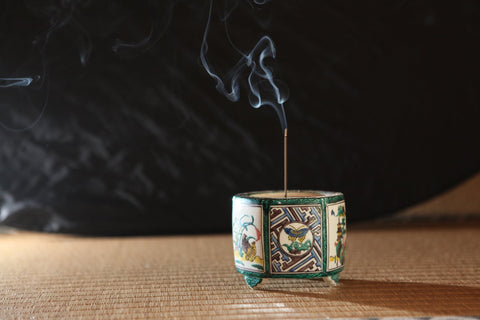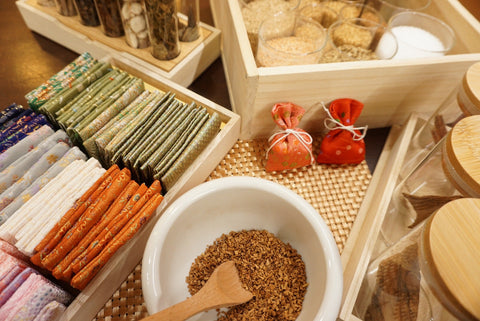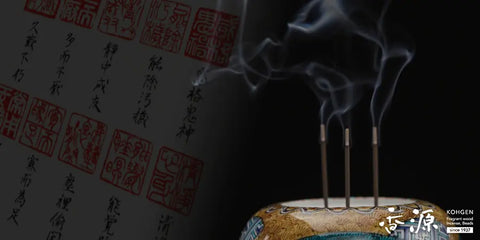
The history of Japanese incense (kōdō) in Japan began approximately 1,400 years ago.
This page looks back on the history of incense in Japan and introduces the types of incense that were popular in each era.
Kofun & Asuka Period (c. 3rd–7th century)


The oldest record of incense in Japan is found in the historical text Nihon Shoki. In the 3rd year of Empress Suiko’s reign (595 AD), a large piece of driftwood washed ashore on present-day Awaji Island. When the locals burned it as firewood, an indescribably pleasant fragrance filled the air.
The surprised islanders offered the wood to the court, and Prince Shōtoku, after smelling it, identified it as “jinkō (agarwood).” This episode suggests that agarwood was already known in Japan at that time.
Since Buddhism had already been introduced to Japan, the presence of incense—inseparable from Buddhist practices—was also known. Nihon Shoki mentions incense being offered in worship of the Buddha, likely using Chinese herbal incense materials. This practice is considered the origin of today’s incense offering (shōkō).
The surprised islanders offered the wood to the court, and Prince Shōtoku, after smelling it, identified it as “jinkō (agarwood).” This episode suggests that agarwood was already known in Japan at that time.
Since Buddhism had already been introduced to Japan, the presence of incense—inseparable from Buddhist practices—was also known. Nihon Shoki mentions incense being offered in worship of the Buddha, likely using Chinese herbal incense materials. This practice is considered the origin of today’s incense offering (shōkō).
Popular Incense in the Kofun & Asuka Period
Nara Period (710–794)


A key historical figure of the Nara period is Jianzhen (Ganjin Wajō), a Chinese monk and envoy. He finally succeeded in traveling to Japan on his sixth attempt, though he lost his eyesight during the journey. He brought to Japan various things previously unknown, including ordination systems, architecture, and medicinal herbs.
Among his records is a list that includes “medicines and fragrances.” By blending herbs and incense materials brought from the Tang dynasty, more effective medicines were created than by using individual ingredients. This introduction of incense blending led to the use of combined incense for Buddhist rituals.
During this time, incense also began to be used for practical purposes such as protection against evil and insects. Supporting this, the Shōsōin of Tōdaiji Temple in Nara houses the oldest known incense sachet (fragrant pouch) in Japan.
Among his records is a list that includes “medicines and fragrances.” By blending herbs and incense materials brought from the Tang dynasty, more effective medicines were created than by using individual ingredients. This introduction of incense blending led to the use of combined incense for Buddhist rituals.
During this time, incense also began to be used for practical purposes such as protection against evil and insects. Supporting this, the Shōsōin of Tōdaiji Temple in Nara houses the oldest known incense sachet (fragrant pouch) in Japan.
Popular Incense in the Nara Period
Heian Period (794–1185)


While incense was closely tied to Buddhism, during the Heian period it became deeply integrated into aristocratic daily life. This era saw the development and popularization of kneaded incense in pill-like form, known as nerikō.
Nobles would blend their own fragrances, creating unique personal scents. They would scent clothing using incense burners like “fukuro,” and scent rooms in practices known as Kunoe-kō (for garments) and Sora-daki (for rooms).
Among the aristocracy, a pastime called Takimono-awase became popular, where participants competed over the quality of their original incense blends. Incense culture matured, leading to the six traditional types of kneaded incense known today.
Nobles would blend their own fragrances, creating unique personal scents. They would scent clothing using incense burners like “fukuro,” and scent rooms in practices known as Kunoe-kō (for garments) and Sora-daki (for rooms).
Among the aristocracy, a pastime called Takimono-awase became popular, where participants competed over the quality of their original incense blends. Incense culture matured, leading to the six traditional types of kneaded incense known today.
Popular Incense in the Heian Period
Kamakura Period (1185–1333)


Power shifted from Heian aristocracy to the samurai class in the Kamakura period. New Buddhist sects known as Kamakura Buddhism emerged. The current method of offering incense by pinching it and placing it in the burner is believed to have spread via Zen during this era.
Under Zen influence, incense culture spread among samurai—not as kneaded incense, but as the appreciation of a single fragrant wood such as agarwood. This simpler style resonated with the samurai spirit and later evolved into the art of kōdō (the Way of Incense).
Under Zen influence, incense culture spread among samurai—not as kneaded incense, but as the appreciation of a single fragrant wood such as agarwood. This simpler style resonated with the samurai spirit and later evolved into the art of kōdō (the Way of Incense).
Popular Incense in the Kamakura Period
Muromachi Period (1336–1573)


During the reign of the 8th shogun, Ashikaga Yoshimasa, cultural investments were made in literature, art, and architecture, leading to great developments.
Incense also evolved significantly. From the late Kamakura to mid-Muromachi periods, a game called Tōkō, where participants distinguished different fragrances of fragrant wood, became popular among nobles, samurai, and wealthy commoners. This practice laid the foundation for the incense arts of Monkō and Kumikō.
In the later Muromachi period, two key figures—Sanjonishi Sanetaka and Shino Sōshin—are considered the founders of modern kōdō. Their schools are now the two major traditions: Oie-ryū and Shino-ryū.
Incense also evolved significantly. From the late Kamakura to mid-Muromachi periods, a game called Tōkō, where participants distinguished different fragrances of fragrant wood, became popular among nobles, samurai, and wealthy commoners. This practice laid the foundation for the incense arts of Monkō and Kumikō.
In the later Muromachi period, two key figures—Sanjonishi Sanetaka and Shino Sōshin—are considered the founders of modern kōdō. Their schools are now the two major traditions: Oie-ryū and Shino-ryū.
Popular Incense in the Muromachi Period
・Tōkō (the foundation of modern Monkō)
Want to Learn More About Incense?
If you’d like to dive deeper into the world of Japanese incense, why not try Kohgen’s incense correspondence course?
Unlike regular in-store lessons, this course is perfect for those who prefer to study at their own pace or want to learn quietly and carefully at home.



